| author | Sang-Hee Shim and Minhaeng Cho |
|---|---|
| journal | Chemical Science (DOI: 10.1039/c8sc03558j) |
| Homepage | https://cmsd.ibs.re.kr/html/cmsd_en/ |
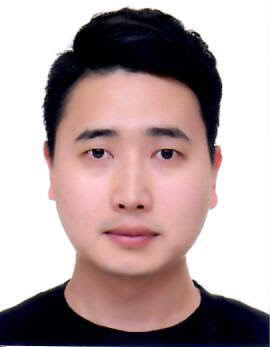
Euihyun Lee(이의현, 박사과정, 제1저자)
Fluorescent proteins contain an internal chromophore constituted of amino acids or an external chromophore
covalently bonded to the protein. To increase their fluorescence intensities, many research groups have
attempted to mutate amino acids within or near the chromophore. Recently, a new type of fluorescent
protein, called UnaG, in which the ligand binds to the protein through many noncovalent interactions was
discovered. Later, a series of mutants of the UnaG protein were introduced, which include eUnaG with
valine 2 mutated to leucine emitting significantly stronger fluorescence than the wild type and V2T mutant,
in which valine 2 is mutated to threonine, emitting weaker fluorescence than the wild type. Interestingly,
the single mutation sites of both eUnaG and V2T mutants are distant from the fluorophore, bilirubin, which
renders the mechanism of such fluorescence enhancement or reduction unclear. To elucidate the origin of
fluorescence intensity changes induced by the single mutations, we carried out extensive analyses on MD
simulations for the original UnaG, eUnaG and V2T, and found that the bilirubin ligand bound to eUnaG is
conformationally more rigid than the wild-type, particularly in the skeletal dihedral angles, possibly resulting
in the increase of quantum yield through a reduction of non-radiative decay. On the other hand, the
bilirubin bound to the V2T appears to be flexible than that in the UnaG. Furthermore, examining the
structural correlations between the ligand and proteins, we found evidence that the bilirubin ligand is
encapsulated in different environments composed of protein residues and water molecules that increase or
decrease the stability of the ligand. The changed protein stability affects the mobility and confinement of
water molecules captured between bilirubin and the protein. Since the flexible ligand contains multiple
hydrogen bond (H-bond) donors and acceptors, the H-bonding structure and dynamics of bound water
molecules are highly correlated with the rigidity of the bound ligand. Our results suggest that, to
understand the fluorescence properties of protein mutants, especially the ones with noncovalently bound
fluorophores with internal rotations, the interaction network among protein residues, ligand, and water
molecules within the binding cavity should be investigated rather than focusing on the local structure near
the fluorescing moiety. Our in-depth simulation study may offer a foundation for the design principles for
engineering this new class of fluorescent proteins.
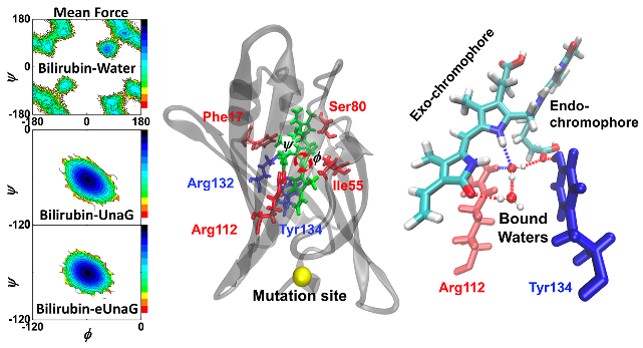
This article is part of the themed collection: 2018 Chemical Science HOT Article Collection
https://pubs.rsc.org/en/Content/ArticleLanding/2018/SC/C8SC03558J#!divAbstract
-
Read More

Gas phase conformations of intrinsically disordered proteins and their complexes with ligands: Kinetically trapped states during transfer from solution to the gas phase
Jong Yoon Han(한종윤, 제1저자, 박사과정) Flexible structures of intrinsically disordered proteins (IDPs) are crucial for versatile functions in living organisms, which involve interaction with diverse partners. Electrospray ionization ion m... -
Read More
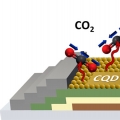
Multifunctional Self-Doped Nanocrystal Thin-Film Transistor Sensors
Dongsun Choi(제1저자, 통합과정) Self-doping in nanocrystals allows accessing higher quantum states. The electrons occupying the lowest energy state of the conduction band form a metastable state that is very sensitive to the electrostatic p... -
Read More

Fine-tuning of wettability in a single metal–organic framework via postcoordination modification and its reduced graphene oxide aerogel for oil–water separation
Sunhwi Eom(제1저자) Elaborate control of wettability in a single platform is essential for materials’ applications towards oil–water separation, but it still remains challenging. Herein, we performed postcoordination modification of Mg2(dob... -
Read More

Harnessing Intramolecular Rotation to Enhance Two‐photon Imaging of Aβ Plaques Through Minimizing Background Fluorescence
Jinwoo Shin(제1저자 석박통합과정) The aggregation of Aβ‐proteins in senile plaques is a critical event during the development of Alzheimer’s disease, and the postmortem detection of Aβ‐rich proteinaceous deposits via fluorescent staining re... -
Read More
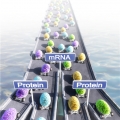
Proteogenomic Characterization of Human Early-Onset Gastric Cancer
Dong-Gi Mun(제1저자, 박사과정) We report proteogenomic analysis of diffuse gastric cancers (GCs) in young populations. Phosphoproteome data elucidated signaling pathways associated with somatic mutations based on mutation-phosphorylation co... -
Read More

Chemiluminescent Probe for the In Vitro and In Vivo Imaging of Cancers Over-Expressing NQO1
Activatable (turn-on) probes that permit the rapid, sensitive, selective, and accurate identification of cancer-associated biomarkers can help drive advances in cancer research. Herein, a NAD(P)H:quinone oxidoreductase- 1 (NQO1)-specific ch... -
Read More

Molecularly Controlled Stark Effect Induces Significant Rectification in Polycyclic Aromatic Hydrocarbon-terminated n-Alkanethiolates
Soo Jin Cho(제1저자, 석박통합과정) Gyu Don Kong(공동 제1저자, 박사과정) Variation of electronic structure of individual molecules as a function of applied bias matters for performance of molecular and organic electronic devices. Understandi... -
Read More

A New Approach for Large-Area Thermoelectric Junctions with Liquid Eutectic Gallium-Indium Electrode
Sohyun Park(박소현, 통합과정, 제1저자) A challenge in organic thermoelectrics is to relate thermoelectric performance of devices to the chemical and electronic structures of organic component inside them on a molecular scale. To this end, a... -
Read More

Nanometric Water Channels in Water-in-Salt Lithium Ion Battery Electrolyte
Joonhyung Lim(임준형, 박사과정, 제1저자) Lithium-ion batteries (LIBs) have been deployed in a wide range of energy-storage applications and helped to revolutionize technological development. Recently, a lithium ion battery that uses superco... -
Read More

Topotactic Transformations in an Icosahedral Nanocrystal to Form Efficient Water-Splitting Catalysts
Designing high‐performance, precious‐metal‐based, and economic electrocatalysts remains an important challenge in proton exchange membrane (PEM) electrolyzers. Here, a highly active and durable bifunctional electrocatalyst for PEM electroly... -
Read More

Fluorescence enhancement of a ligand-activated fluorescent protein induced by collective noncovalent interactions
Euihyun Lee(이의현, 박사과정, 제1저자) Fluorescent proteins contain an internal chromophore constituted of amino acids or an external chromophore covalently bonded to the protein. To increase their fluorescence intensities, many research gr... -
Read More

Elucidating the Role of Molecule-Electrode Interfacial Defects in Charge Tunneling Characteristics of Large-area Junctions
Gyu Don Kong(공규돈, 박사과정, 제1저자) / Junji Jin(김준길, 석사과정, 제2저자) Interfacial chemistry at organic-inorganic contact critically determines function of a wide range of molecular and organic electronic devices and other systems. ... -
Read More

PDMS-Coated Hypercrosslinked Porous Organic Polymers Modified via Double Postsynthetic Acidifications for Ammonia Capture
Dong Won Kang(강동원, 통합과정, 제1저자) / Minjung Kang(강민정, 통합과정, 제2저자) A hypercrosslinked porous organic polymer was modified by post-oxidation and post-sulfonation to obtain a porous platform with high density of acidic groups.... -
Read More

Accurate Quantification of N-glycolylneuraminic Acid in Therapeutic Proteins Using Supramolecular Mass Spectrometry
Hyun Hee L. Lee (이현희, 박사과정, 제1저자) / Chae Eun Heo (허채은, 박사과정, 제 2저자) Practical applications of innovative host-guest systems are challenging because of unexpected guest competitors and/or subtle environmental differences.... -
Read More
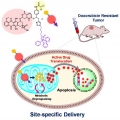
Overcoming Drug Resistance by Targeting Cancer Bioenergetics with an Activatable Prodrug
Nearly without exception, all known cancer chemotherapeutics elicit a resistance response over time. The resulting resistance is correlated with poor clinical outcomes. Here we report a new approach to overcoming resistance that involves rep... -
Read More

Janus Nanoparticle Structural Motif Control via Asymmetric Cation Exchange in Edge-Protected Cu1.81S@IrxSy Hexagonal Nanoplates
Post-synthetic transformation of nanoparticles has received great attention, because this approach can provide an unusual route to elaborately composition-controlled nanostructures while maintaining the overall structure of the template. In... -
Read More

Deconvolution of Tunneling Current in Large-area Junctions Formed with Mixed Self-Assembled Monolayers
Junji Jin(석사과정) Gyu Don Kong(박사과정) Whereas single-component self-assembled monolayers (SAMs) have served widely as organic components in molecular and organic electronics, how the performance of the device is influenced by the hetero... -
Read More

Electron heating and thermal relaxation of gold nanorods revealed by two-dimensional electronic spectroscopy
To elucidate the complex interplay between the size and shape of gold nanorods and their electronic, photothermal, and optical properties for molecular imaging, photothermal therapy, and optoelectronic devices, it is a prerequisite to charac... -
Read More

(Semi)ladder-Type Bithiophene Imide-Based All-Acceptor Semiconductors: Synthesis, Structure–Property Correlations, and Unipolar n-Type Transistor Performance
Development of high-performance unipolar n-type organic semiconductors still remains as a great challenge. In this work, all-acceptor bithiophene imide-based ladder-type small molecules BTIn and semiladder-type homopolymers PBTIn (n = 1–5) w... -
Read More

Dendrite-Embedded Platinum–Nickel Multiframes as Highly Active and Durable Electrocatalyst toward the Oxygen Reduction Reaction
Hyukbu Kwon(석사과정) Jongsik Park(박사과정) Pt-based nanoframe catalysts have been explored extensively due to their superior activity toward the oxygen reduction reaction (ORR). Herein, we report the synthesis of Pt–Ni multiframes, which ...


 Topotactic Transformations in an Icosahedral Nanocrystal to F...
Topotactic Transformations in an Icosahedral Nanocrystal to F...
 Elucidating the Role of Molecule-Electrode Interfacial Defect...
Elucidating the Role of Molecule-Electrode Interfacial Defect...